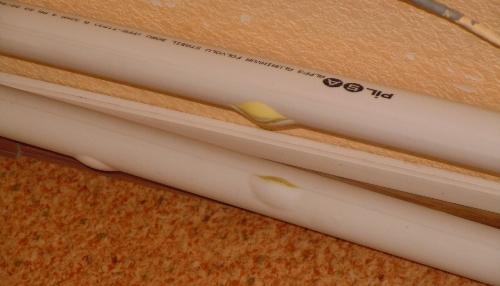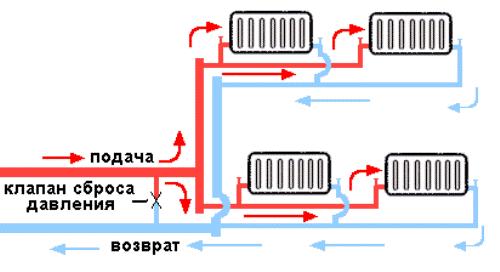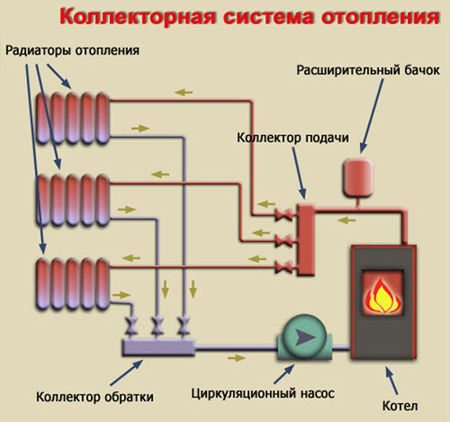Heating of a suburban two-storey house is an important part of the arrangement of life. Despite the development of new technologies in this area, the heating system of the two-story house is the heat carrier, in which water circulating through the pipes.
Content
Water heating principle
The project of heating a two-story house based on such a system is quite simple. Water heats up with a boiler, after which it enters the batteries through the pipes, and then flows back to the boiler. In order to maintain heat exchange, the circulation pump must be in the system. As a fuel for the boiler is used:
- natural gas;
- coal;
- firewood;
- kerosene, etc.
Water heating can be carried out with the help of electricity or energy of the Sun, but natural gas is most often used. The system (depending on the project conditions) may consist of the following devices:
- heating boiler;
- batteries (radiators);
- pipes;
- expansion tank (for garbage collection);
- circulation pump;
- thermostators;
- airlighteners;
- pressure gauge;
- safety valve.
Choice of boiler for home heating
Depending on which area it is necessary to heat, the power of the boiler is chosen. For a small house with a heated area from 60 to 200 m², there is enough boiler with a capacity of up to 25 kW, for home 200-300 m² will be required to 35 kW, for the area 300-600 - up to 60 kW.
Information about the pipes used in the system
For transportation of the coolant, pipes from different materials can be used.
- Stainless steel, from ordinary steel and covered with a protective layer of zinc. When installing them, they are connected by welding or on the coils (special parts with thread). Stainless pipes serve longer, and from steel - subject corrosion. In recent years, such pipes have been practically not used.
- Copper pipes withstand high temperatures and are not subject to corrosion. Combined soldering with a solder containing silver. Such pipes are expensive, but they have a longer service life than others.
- Polymer pipes are made of polyethylene, polypropylene. For strength, they are reinforced by aluminum (its layer is average in the wall). Such pipes are not subject to corrosion, do not "overgrow" from the inside and easily connect to the thermocouple. The disadvantage is a tendency to thermal, which can cause leaks when defrosting the system.
The choice of diameter and pipe material is carried out in accordance with the project, which should take into account the features of the house architecture, the technical characteristics of the boiler and the properties of the fuel.
Varieties of water heating systems
The water heating of the two-storey house can be organized using a single-circuit or two-circuit system. The latter is also designed for heating, and to provide hot water. In some cases, two single-circuit systems are used: water for heating is prepared with the help of a boiler, and water for household needs - with a gas column. This makes it possible to repair each system independently.
There are the following ways of laying pipes on the premises:
- one-tube heating of a two-storey house;
- two-pipe;
- collector.
In some cases, mixed systems are used: it allows the floor heating and deliver the coolant to radiators fixed on the walls.
One-tube pipe wiring: advantages and disadvantages
The principle of the single-tube system is that the adjacent water goes to the radiators on one pipe and then by giving heat energy, returns to the boiler for heating. A single-tube system provides the upper supply of the coolant, and there are no reverse risers.
- With a single-tube wiring, the coolant passes through the pipe, moving from the melee to the radiator boiler to the long-distance.
- When installing the heating system in this way, materials will significantly save. Aesthetically, such a layout looks better than others (if the pipes are not hidden in the wall).
- A single-tube system makes it difficult to adjust the temperature in different rooms.
- It is possible to disable only the latter in the chain of radiators for repair. If the leakage occurs, disable the entire system.
- The temperature of the radiators in different rooms will differ. In this case, the temperature of the latter will always be lower than the first.
- There are two ways to install a single-tube system: with a dead-end (counter) and associated movement of the coolant.
- On the lower floor it is necessary to increase the number of radiator sections, as water pipes flow from the top floor already partially chilled.
There are several ways to connect radiators:
- flowing (between the incoming and outgoing pipe there is a connection only on the radiator, that is, the bypass is absent);
- with an unregulated bypass (there are no cranes and valves to adjust or turn off the battery);
- with manually adjustable bypass (ball valves are installed on the bypass and before entering the pipe in the battery);
- with a three-way crane, adjusting bypass and input (bypass you can adjust both manually and automatically).
What is two-pipe layout
The heating of a two-story private house is better to mount on the principle of a two-pipe system. It allows you to adjust the temperature in the premises more efficiently and is best suited for private houses. This principle lies in the fact that a pipe with a heated heat carrier and a cold pipe is supplied to each radiator.
There are several ways to distribute pipes with a two-pipe system:
- Star-like: a pipe with a hot heat carrier is connected to the radiator, and leaves with cold. At the same time, the temperature of all batteries is the same.
- Method "Clay": Batteries are located one after another, while on one pipe to each, hot water is consistently supplied and the cold one is given. This way is worse than the previous one, since the low-speed radiators are stronger than distant.
- Collector (radial) wiring: In this case, a collector cabinet is installed near the free wall (if possible - in the built-in method), and in it two collectors: for hot and cold pipes. Putting the pipes to batteries are performed under the tie. This allows you to hide the wiring, and in addition, make the floor warm. The advantage of the collector system is the ability to easily adjust the temperature: each output on the collector is equipped with a shut-off reinforcement. If necessary, you can completely disable any radiator.
Correctly calculate and manufacture a project of the heating system for the house can only be familiar with the laws of thermodynamics and the basics of heat engineering. However, the information will be useful to the customer in order to make the right choice and be able to control the system.
It is better to get acquainted with the device of various heating systems will help the video.




























